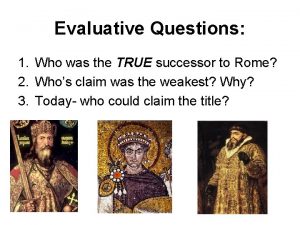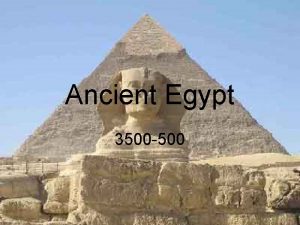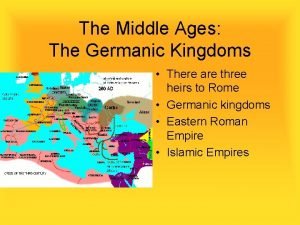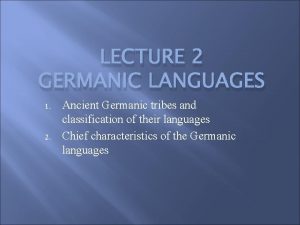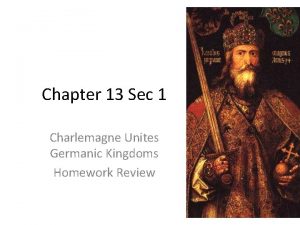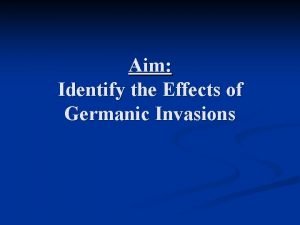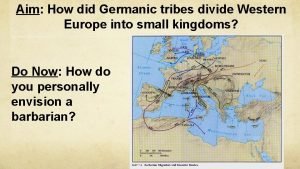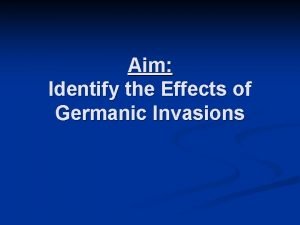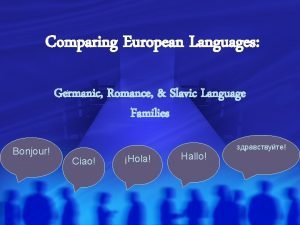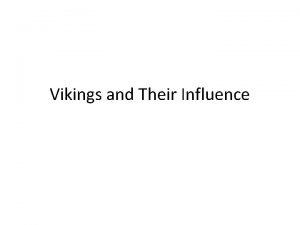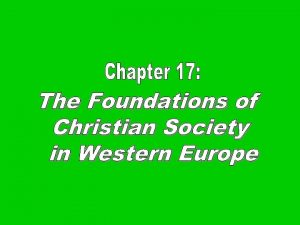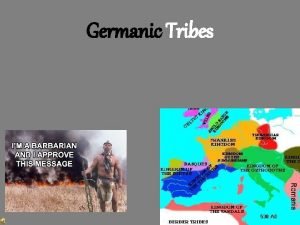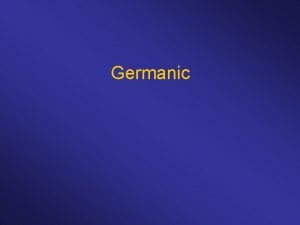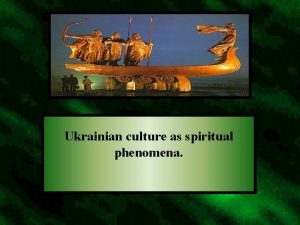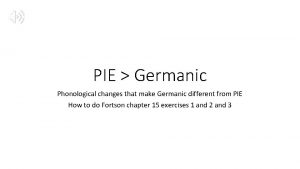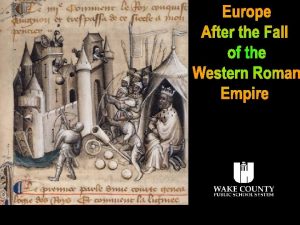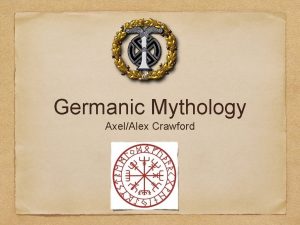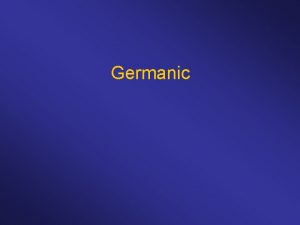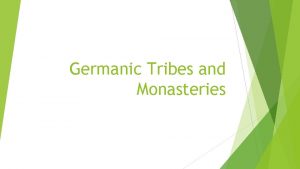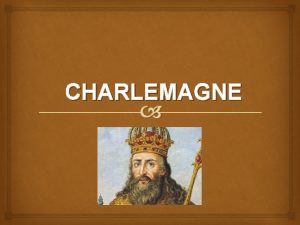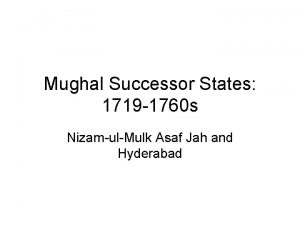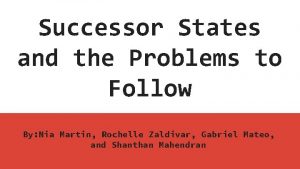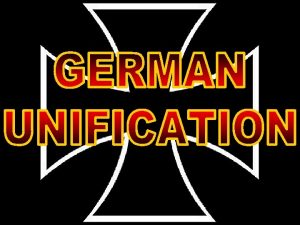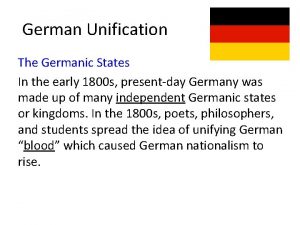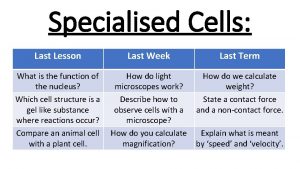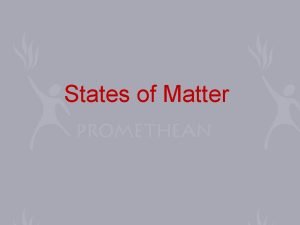The Germanic Successor States c 500 CE Last




















































- Slides: 52


The Germanic Successor States, c. 500 CE • Last Roman emperor deposed by Germanic Odoacer, 476 CE • Administrative apparatus still in place, but cities lose population • Germanic successor states: – Spain: Visigoths – Italy: Ostrogoths – Gaul: Burgundians, Franks – Britian: Angles, Saxons

Successor States to the Roman Empire c. 500

The Frankish Empire • In the territory known as Gaul, and what is currently the country of France, the Franks emerged as the dominant tribe in the area. • In the late 400’s, Clovis was the first king of the Franks to unite all the Frankish tribes under one ruler. His conversion to Christianity gained him a great ally in the Roman Catholic Church.

The Franks • Heavy influence on European development • Strong agricultural base • Shifts center of economic gravity to Europe • Firm alliance with western Christian church

Clovis (ruled 481 -511) • Major Frankish leader • Destroyed last vestiges of Roman rule in Gaul • Dominated other Germanic peoples • Franks establish themselves as preeminent Germanic people

Clovis’ Conversion to Christianity • Paganism, Arian Christianity popular among Franks • Clovis and army chooses Roman Catholicism • Influence of wife Clotilda • Political implications: – Alliance with western church

The Carolingians • Charles “The Hammer” Martel begins Carolingian dynasty • Defeats Spanish Muslims at Battle of Tours (732) – Halts Islamic advance into western Europe

Charles de Steuben's Bataille de Poitiers en Octobre 732 depicts a triumphant Charles Martel (mounted) facing ‘Abdul Rahman Al Ghafiqi (right) at the Battle of Tours.


The Carolingian Empire

Charlemagne (r. 768 -814) • Grandson of Charles Martel • Centralized imperial rule • Functional illiterate, but sponsored extensive scholarship • Major military achievements

Charlemagne’s Empire

Charlemagne’s Administration • • Capital at Aachen, Germany Yet constant travel throughout empire Spread Christianity Set Up Education System – Increased Scriptoriums – Alcuin, the leading scholar and educator under Charlemagne introduced the 7 liberal arts • Begins Romanesque Architecture • Expansion of Territory • Imperial officials: missi dominici (“envoys of the lord ruler) – Continued yearly circuit travel

Romanesque church in Normandy Romanesque church in Poland

Charlemagne as Emperor • Hesitated to challenge Byzantines by taking title “emperor” – Yet ruled in fact • Pope Leo III crowns him as emperor in 800 – Planned in advance? – Challenge to Byzantium

Pope Crowned Charlemagne Holy Roman Emperor: Dec. 25, 800

The Carolingian Renaissance

Carolingian Miniscule

Louis the Pious (r. 814 -840) • Son of Charlemagne • Lost control of courts, local authorities • Civil war erupts between three sons • Empire divided in 843 Charlemagne crowns Louis the Pious

Charlemagne’s Empire Collapses: Treaty of Verdun, 843

Invasions • South: Muslims • East: Magyars • North: Vikings – Norse expansion begins c. 800 CE – Driven by population pressure, hostility to spread of Christianity – Superior seafaring technology – Sailed to eastern Canada, northeastern US

The dissolution of the Carolingian Empire (843 CE – divided amongst Charlemagne’s grandchildren) and the invasions of early medieval Europe in the ninth and tenth centuries

The Vikings • From village of Vik, Norway (hence “Viking”) • Boats with shallow drafts, capable of river travel as well as open seas • Attacked villages, cities from 9 th century – Constantinople sacked three times • Carolingians had no navy, dependent on local defenses

England • Viking invasions force consolidation of Angles, Saxons and other Germanic peoples under King Alfred (r. 871 -899) • Built navy • Fortified cities against attack

Germany and France • King Otto of Saxony (r. 936 -973) defeats Magyars, 955 • Proclaimed emperor by Pope in 962 • Establishment of Holy Roman Empire • France endures heavy Viking settlement • Loss of local autonomy

Early Medieval Society • Concept of Feudalism – Lords and vassals – Increasingly inadequate model for describing complex society • Ad hoc arrangements in absence of strong central authorities

Feudalism A political, economic, and social system based on loyalty and military service.

Organizing in a Decentralized Society • Local nobles take over administration from weak central government • Nominal allegiances, esp. to Carolingian kings • But increasing independence

Lords and Retainers • Formation of small private armies • Incentives: land grants, income from mills, cash payments • Formation of hereditary class of military retainers • Development of other functions – Justice, social welfare

Potential for Instability • Complex interrelationship of lord-retainer relations • Rebellion always a possibility • Nevertheless, viable large states developed (Germany, France, England)

Origins of Serfdom • Slaves, free peasants in both Roman and Germanic societies • Heavy intermarriage • Appeals to lords, special relationships • Mid-7 th century: recognition of serf class – Midway between slave and free peasant

Serfs’ Rights and Obligations • Right to pass on land to heirs • Obligation to provide labor, payments in kind to lord • Unable to move from land • Fees charged for marrying serfs of another lord

Manors • Large, diverse estates • Lord provides governance, police, justice services • Serfs provide labor, income

The Medieval Manor

Life on the Medieval Manor Serfs at work

Women in the Middle Ages • Noblewomen were responsible for the entire running of an estate while her husband was in battle. • All women had very limited inheritance rights, as all possessions went to the oldest son. • In the Middle Ages, the Church portrayed women as weak and easily tempted into sin. Yet, women were also portrayed as modest and pure in spirit. • Learning was generally discouraged for women.

The Economy of Early Medieval Europe • Agricultural center moves north from Mediterranean • 8 th century iron-tipped plow introduced in Europe • Draft animals bred • Water mill technology • Agricultural output insufficient to support growth of cities • Strong Mediterranean trade despite Muslim domination of sea

Norse Merchant Mariners • Commerce or plunder as convenient • Link with the Islamic world for trade

Population Growth of Europe, 200 -1000 CE

The Formation of Christian Europe • Clovis’ conversion forms strong alliance with Roman Christianity • Church supplies Clovis with class of literate information workers: – Scribes – secretaries

The Franks and the Church • Protectors of the Papacy • Charlemagne destroys Lombards, who threatened Pope, Rome • Spreads Christianity in northern areas • Support of scholarship, scribal activity

The Spread of Christianity • Charlemagne fights pagan Saxons (772804) – Saxons later adopt Christianity • Scandinavia, other pockets of paganism until c. 1000 CE

Pope Gregory I (590 -604 CE) • “Gregory the Great” • Asserted papal primacy • Prominent theologian – Sacrament of penance • Major missionary activity, especially in England

Monasticism • Egyptian origins, 2 nd-3 rd centuries • Monastic lifestyle expands 4 th century • Large variety of monastic rules – Range from extremely ascetic to very lax

St. Benedict (480 -547) • Established consistent rule for monasteries – Poverty – Chastity – Obedience • St. Scholastica (482 -543) – Sister of St. Benedict – Adapts Benedictine Rule for convents

A late 15 th-century Scriptorium by of Jean Miélot In the strictest definition of illuminated manuscript, only manuscripts with gold Pope Gregory I, by or silver would be Francisco de Zurbarán considered illuminated. St. Benedict by Fra Angelico, c. 1437 -1446

Monasticism and Society • Accumulation of large landholdings, serfs • Social welfare projects – Esp. labor contributions • Expansion of literacy • Inns, orphanages, hospitals

The Power of the Medieval Church v The church controlled about 1/3 of the land in Western Europe. v Tithe 1/10 tax on your assets given to the church. v Threat of excommunication and an inderdict gave the church tremendous control over European peasants and nobles. v The selling of indulgences, canon law and simony also fortified the church’s power, but led many to recognize these acts as corrupt.

Church Secular Influence & Pope Innocent III • The Church claimed authority over all secular rulers, many of whom did not recognize this authority, often resulting in power struggles between monarchs and popes. • When King John of England challenged Pope Innocent III over the appointment of an archbishop, he was excommunicated in 1209.

Magna Carta, 1215 v King John I v “Great Charter” v Monarchs were not above the law. v Kings had to consult a council of advisors. v Kings could not tax arbitrarily.

The Medieval Church • Everyday Life – Christians attend village churches – Priests run village churches – All Christians pay tithe • Power of the Church – Pope leads – Canon Law – Excommunication/ interdict • Reform -Church wealth & influence - Some clergy corrupted - Reformers • Nuns & Monks -Set up housing, hospitals, schools - Missionaries Preservation of learning
 Successor number
Successor number Autocrat byzantine empire
Autocrat byzantine empire The true successor
The true successor 3500+500
3500+500 Language
Language Germanic branch definition ap human geography
Germanic branch definition ap human geography Germanic kingdom
Germanic kingdom Ancient german language
Ancient german language Charlemagne unites germanic kingdoms
Charlemagne unites germanic kingdoms Effects of germanic invasions
Effects of germanic invasions Language in english
Language in english Germanic
Germanic How did germanic tribes divide western europe
How did germanic tribes divide western europe Effects of germanic invasions
Effects of germanic invasions Germanic romance slavic
Germanic romance slavic What languages come from latin
What languages come from latin Are scandinavians germanic
Are scandinavians germanic Sources of civil law
Sources of civil law How does the constitution guard against tyranny
How does the constitution guard against tyranny What were the 11 free states
What were the 11 free states Southern states of america
Southern states of america Chúa yêu trần thế alleluia
Chúa yêu trần thế alleluia Các châu lục và đại dương trên thế giới
Các châu lục và đại dương trên thế giới Khi nào hổ con có thể sống độc lập
Khi nào hổ con có thể sống độc lập Từ ngữ thể hiện lòng nhân hậu
Từ ngữ thể hiện lòng nhân hậu Diễn thế sinh thái là
Diễn thế sinh thái là Vẽ hình chiếu vuông góc của vật thể sau
Vẽ hình chiếu vuông góc của vật thể sau Làm thế nào để 102-1=99
Làm thế nào để 102-1=99 Tỉ lệ cơ thể trẻ em
Tỉ lệ cơ thể trẻ em Lời thề hippocrates
Lời thề hippocrates đại từ thay thế
đại từ thay thế Quá trình desamine hóa có thể tạo ra
Quá trình desamine hóa có thể tạo ra Các môn thể thao bắt đầu bằng tiếng nhảy
Các môn thể thao bắt đầu bằng tiếng nhảy Công của trọng lực
Công của trọng lực Hình ảnh bộ gõ cơ thể búng tay
Hình ảnh bộ gõ cơ thể búng tay Sự nuôi và dạy con của hươu
Sự nuôi và dạy con của hươu Thế nào là mạng điện lắp đặt kiểu nổi
Thế nào là mạng điện lắp đặt kiểu nổi Dạng đột biến một nhiễm là
Dạng đột biến một nhiễm là Nguyên nhân của sự mỏi cơ sinh 8
Nguyên nhân của sự mỏi cơ sinh 8 Vẽ hình chiếu đứng bằng cạnh của vật thể
Vẽ hình chiếu đứng bằng cạnh của vật thể Phản ứng thế ankan
Phản ứng thế ankan Voi kéo gỗ như thế nào
Voi kéo gỗ như thế nào Thiếu nhi thế giới liên hoan
Thiếu nhi thế giới liên hoan điện thế nghỉ
điện thế nghỉ Một số thể thơ truyền thống
Một số thể thơ truyền thống Thế nào là hệ số cao nhất
Thế nào là hệ số cao nhất Trời xanh đây là của chúng ta thể thơ
Trời xanh đây là của chúng ta thể thơ Slidetodoc
Slidetodoc Bảng số nguyên tố
Bảng số nguyên tố đặc điểm cơ thể của người tối cổ
đặc điểm cơ thể của người tối cổ Vẽ hình chiếu vuông góc của vật thể sau
Vẽ hình chiếu vuông góc của vật thể sau Các châu lục và đại dương trên thế giới
Các châu lục và đại dương trên thế giới Tư thế worm breton
Tư thế worm breton


